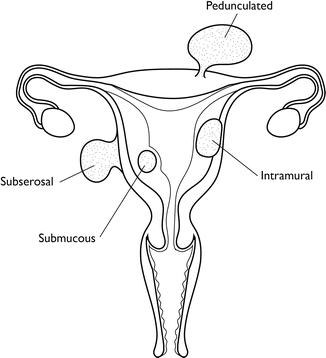and Paula Briggs2
(1)
Department of Obstetrics and Gynaecology, Monash University, Clayton, Victoria, Australia
(2)
Sexual and Reproductive Health, Southport and Ormskirk Hospital, Southport, UK
Definition
Fibroids are benign neoplastic lesions of the fibrous and muscle tissue of the uterus.
Incidence
They occur commonly, especially between 25 and 45 years of age. They are 2–3 times more common in Afro-caribean women.
Aetilogy and Pathogenesis
The cause of fibroids is unknown. The growth of fibroids depends on oestrogen, and they shrink after the menopause.
There is a familial tendency, but no specific genetic marker has been identified.
Fibroids are classified as subserous (on the peritoneal aspect of the uterus), intramural (within the wall of the uterus) and sub-mucous (distorting the uterine cavity), and pedunculated (Fig. 13.1).


Fig. 13.1
Uterine fibroids
Clinical Assessment
History
Fibroids are often asymptomatic.
Symptoms depend on the position and the size of the fibroid(s).
Abnormal bleeding – HMB and IMB can occur.
Pain
Dysmenorrhoea – pain due to passing clots.
Haemorrhage within the substance of the fibroid (red degeneration) can also cause pain (this is more common during pregnancy). Fibroids may cause pressure on pelvic nerves also causing pain, although this is uncommon.
Stay updated, free articles. Join our Telegram channel

Full access? Get Clinical Tree


